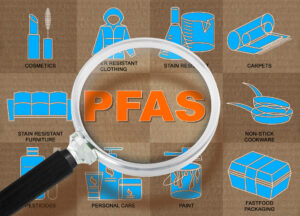
EPA finalizes PFAS contamination rule, categorizes 2 more chemicals as hazardous substances
By onLegal
The U.S. Environmental Protection Agency (EPA) has taken another step to mitigate health risks caused by “forever chemicals.”
Earlier this month, the agency released updated interim guidance on the destruction and disposal of perfluoroalkyl and polyfluoroalkyl, also known as PFAS, some of which are used by collision repair shops. Public comment on the guidance is open online.
EPA says they’re found in adhesives, coatings for clothes and furniture, and fire-fighting foam among other widespread use in consumer, commercial, and industrial products. Exposure has been linked to cancers, impacts on the liver and heart, and immune and developmental damage to infants and children, according to the EPA.
On Friday, the EPA announced its final PFAS rule will also designate two widely used forever chemicals, perfluorooctanoic acid (PFOA) and perfluorooctanesulfonic acid (PFOS), as hazardous substances under the Comprehensive Environmental Response, Compensation, and Liability Act (CERCLA), also known as Superfund, and will help ensure that polluters pay to clean up their contamination.
This final rule includes investigation and cleanup of the chemicals and ensuring that leaks, spills, and other releases are reported, EPA said in a news release.
The action builds on recently finalized standards to protect people and communities from PFAS contamination in drinking water. It also represents the latest step the Biden-Harris Administration is taking to protect public health and welfare and the environment under EPA’s PFAS Strategic Roadmap and to prevent cancer before it starts through the Biden Cancer Moonshot, according to the release.
EPA also issued a separate CERCLA enforcement discretion policy that will focus enforcement on parties who significantly contribute to the release of PFAS chemicals into the environment, including those who have created or used PFAS in the manufacturing process, federal facilities, and other industrial parties.
EPA says it seeks to designate PFOA and PFOS under CERCLA because both chemicals meet the statutory criteria for designation as hazardous substances. The designation enables the EPA to compel polluters to pay for or conduct investigations and cleanup rather than taxpayers. The designation is especially important as delay in addressing contamination allows PFOA and PFOS more time to make their way into water and soil, EPA said.
Under the rule, entities are required to immediately report releases of PFOA and PFOS that meet or exceed the reportable quantity of one pound within a 24-hour period to the National Response Center, state, Tribal, and local emergency responders.
“President Biden understands the threat that ‘forever chemicals’ pose to the health of families across the country,” said EPA Administrator Michael S. Regan, in the release. “That’s why EPA launched its PFAS Strategic Roadmap, a whole-of-agency approach to protecting public health and addressing the harm to communities overburdened by PFAS pollution. Designating these chemicals under our Superfund authority will allow EPA to address more contaminated sites, take earlier action, and expedite cleanups, all while ensuring polluters pay for the costs to clean up pollution threatening the health of communities.”
The final rule also means federal entities that transfer or sell their property must provide notice about the storage, release, or disposal of PFOA or PFOS on the property and guarantee that contamination has been cleaned up or, if needed, that additional cleanup will occur in the future. It will also lead the Department of Transportation to list and regulate these substances as hazardous materials under the Hazardous Materials Transportation Act.
EPA’s Superfund program has existed for more than 40 years to target and prioritize cleanups of the nation’s most contaminated sites that present unacceptable risks to human health and the environment, according to the EPA. The program addresses more than 800 hazardous substances including widespread, highly mobile, and persistent chemicals like PFOA and PFOS.
The program also promotes safer industrial practices that enhance community protection by reducing the likelihood of future releases, EPA said.
The final rule will be effective 60 days after publication in the federal register.
Images
Featured image credit: Francesco Scatena/iStock
More information
New EPA chemical, hazardous waste rules to affect collision repair shops
